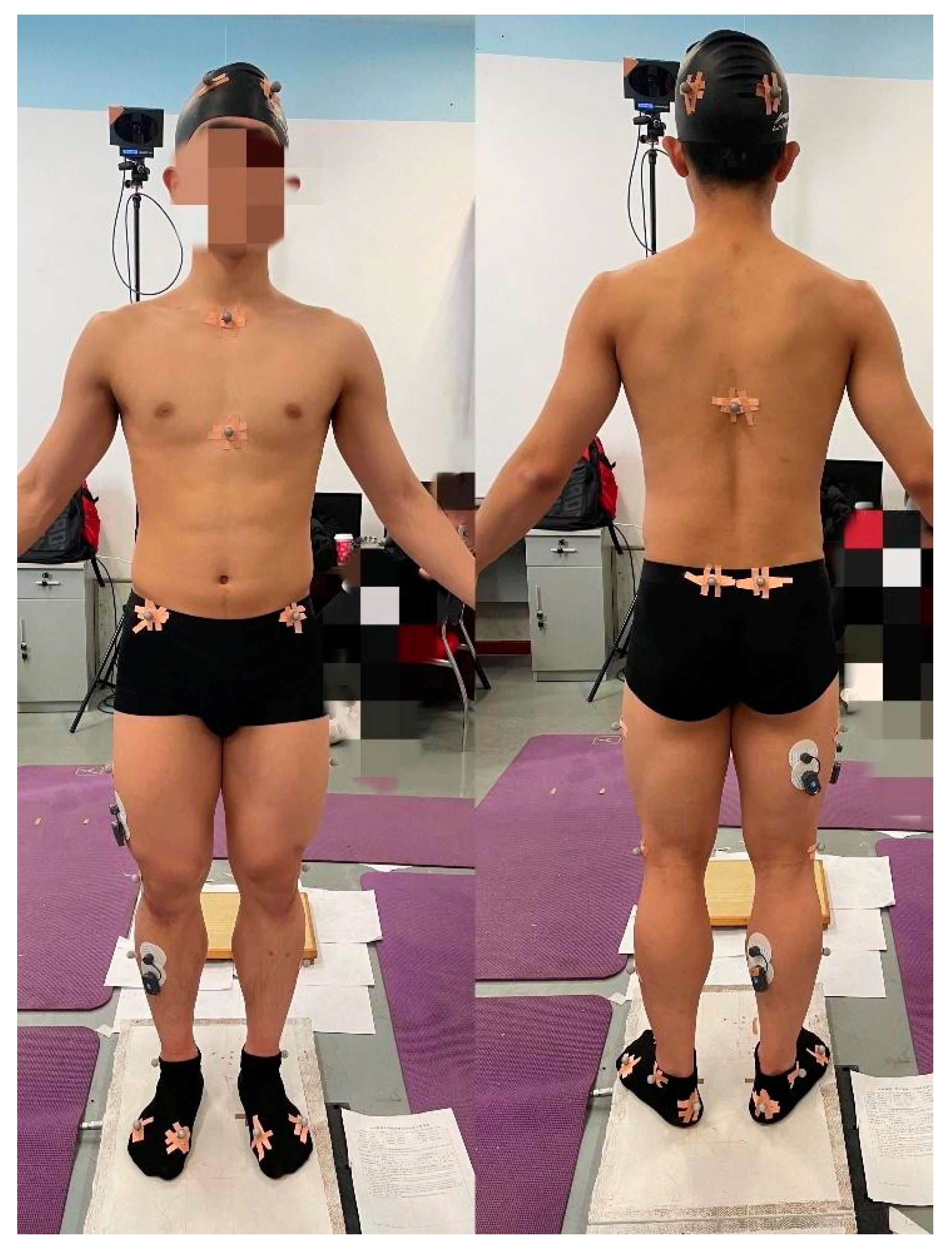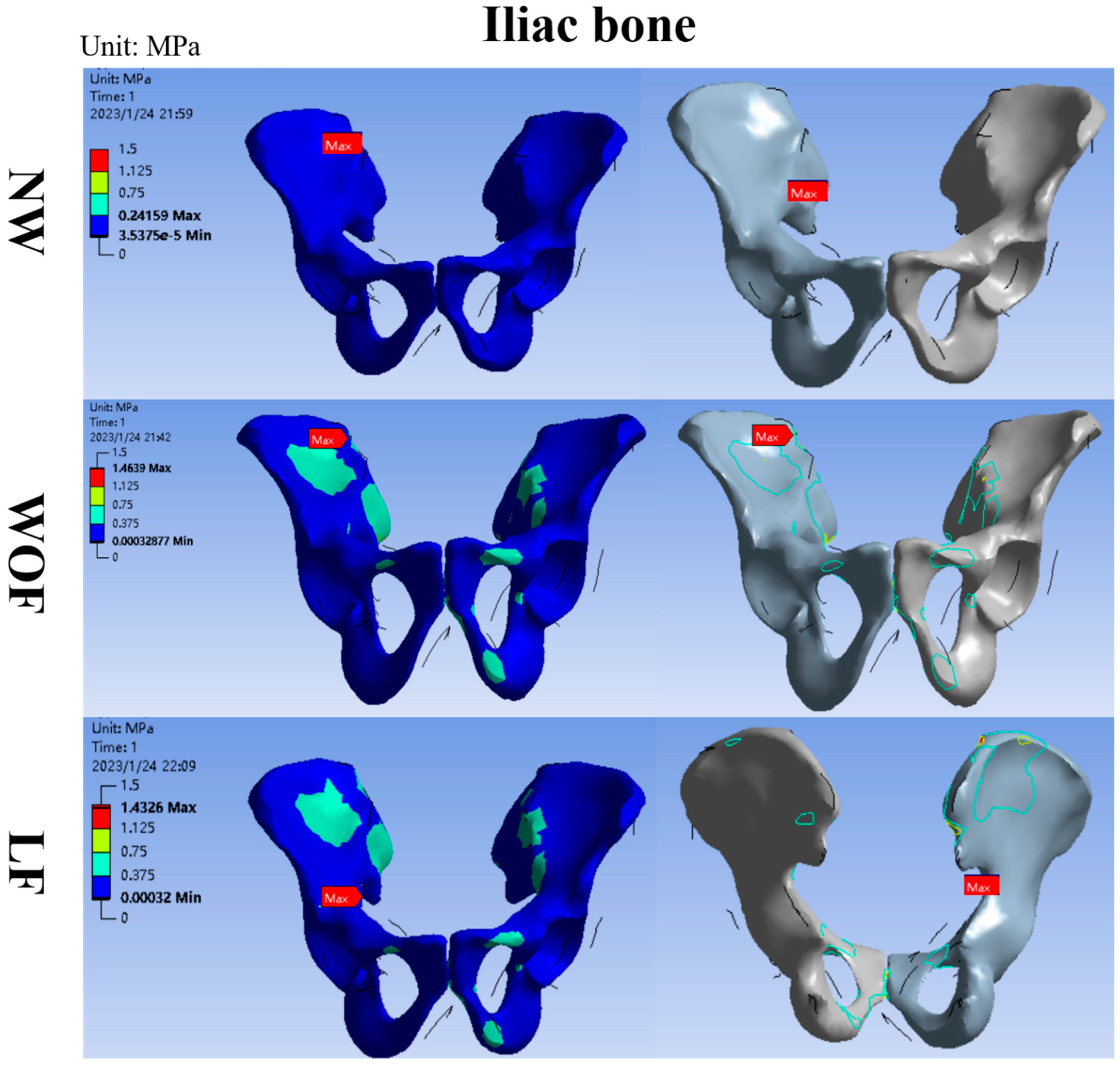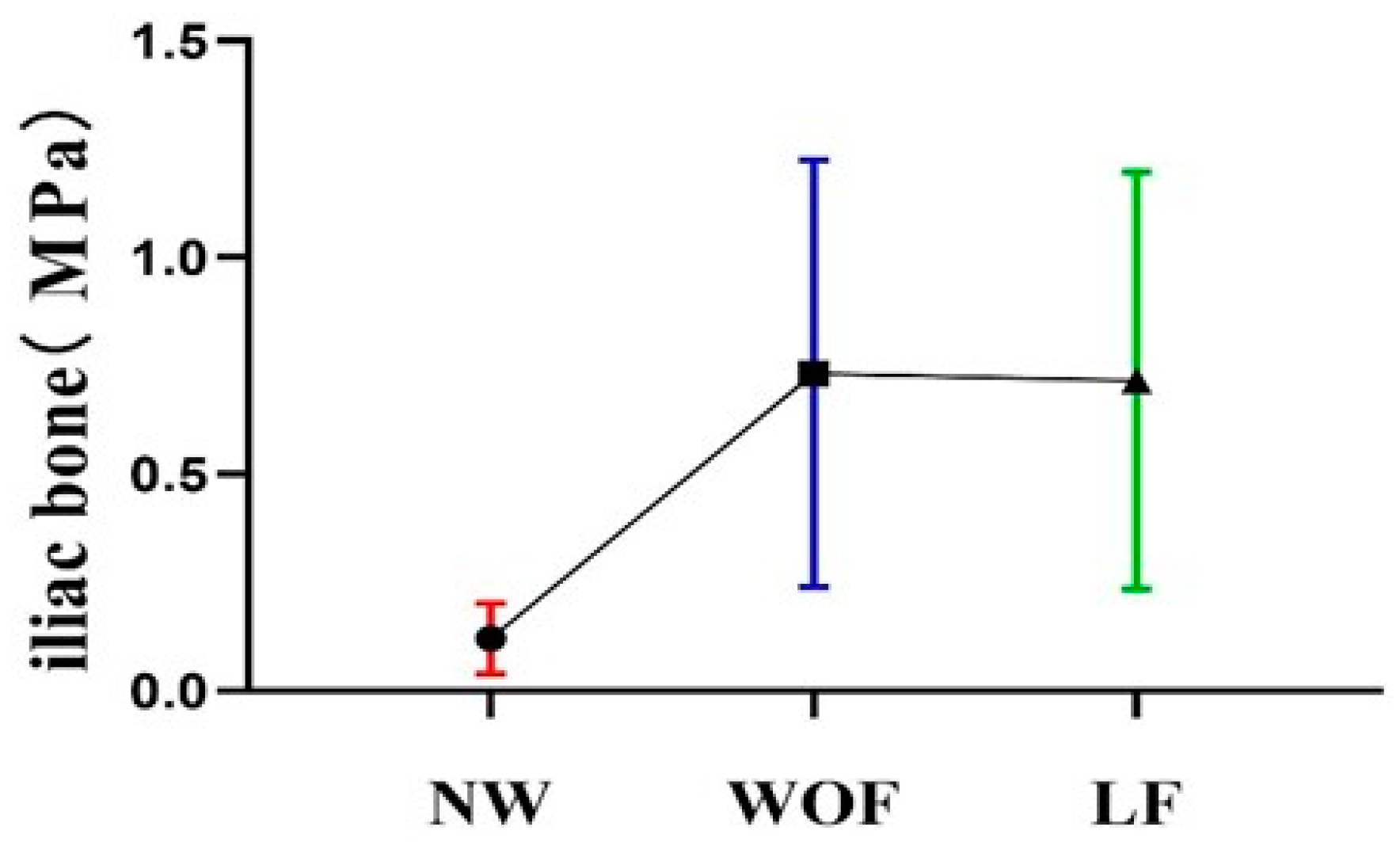Study on Two Typical Progressive Motions in Tai Chi (Bafa Wubu) Promoting Lower Extremity Exercise
Abstract
1. Introduction
2. Materials and Methods
2.1. Participants
2.2. Methods
2.2.1. Instrument
2.2.2. Two Progressive Motions in Tai Chi (Bafa Wubu)
2.2.3. AnyBody Modeling
2.3. Testing Protocols
2.4. Data Collection and Analysis
2.4.1. Force Plate and Electromyography Data Processing
2.4.2. Kinematic and Dynamic Data of the Lower Extremities
2.4.3. Skeleton Finite Element Model Processing
2.4.4. Statistical Analysis
3. Results
3.1. Comparisons of Ground Reaction Force
3.2. Comparisons of Joint Load of the Lower Extremity
3.3. Comparisons of Muscle Strength of the Lower Extremities
3.4. Comparisons of Iliac Bone Stress
4. Discussion
4.1. Ground Reaction Force Characteristics Analysis
4.2. Lower Extremity Joint Characteristics Analysis
4.3. Analysis of Lower Extremity Muscle Characteristics
4.4. Lower Extremity Neuromuscular Characteristics Analysis
5. Conclusions
Author Contributions
Funding
Institutional Review Board Statement
Informed Consent Statement
Data Availability Statement
Conflicts of Interest
Abbreviations
References
- Yang, F.; Liu, W. Individual analysis of dynamic stability for twenty-four Tai Chi forms among persons with knee osteoarthritis: A pilot study. Gait Posture 2021, 86, 22–26. [Google Scholar] [CrossRef]
- Ge, Y.; Liu, H.; Wu, Q.; Chen, A.; Gao, Z.; Xing, F.; Liu, G. Effects of a short eight Tai Chi-forms for the pre-frail elderly people in senior living communities. Physiother. Theory Pract. 2021, 38, 1928–1936. [Google Scholar] [CrossRef] [PubMed]
- Hu, L.; Wang, Y.; Liu, X.; Ji, X.; Ma, Y.; Man, S.; Hu, Z.; Cheng, J.; Huang, F. Tai Chi exercise can ameliorate physical and mental health of patients with knee osteoarthritis: Systematic review and meta-analysis. Clin. Rehabilitation 2020, 35, 64–79. [Google Scholar] [CrossRef] [PubMed]
- Kuo, C.-C.; Chen, S.-C.; Chen, T.-Y.; Ho, T.-J.; Lin, J.-G.; Lu, T.-W. Effects of long-term Tai-Chi Chuan practice on whole-body balance control during obstacle-crossing in the elderly. Sci. Rep. 2022, 12, 2660. [Google Scholar] [CrossRef] [PubMed]
- Kuo, C.-C.; Chen, S.-C.; Wang, J.-Y.; Ho, T.-J.; Lin, J.-G.; Lu, T.-W. Effects of Tai-Chi Chuan Practice on Patterns and Stability of Lower Limb Inter-Joint Coordination During Obstructed Gait in the Elderly. Front. Bioeng. Biotechnol. 2021, 9, 9722. [Google Scholar] [CrossRef]
- Pinto, T.C.C.; Machado, L.; Bulgacov, T.M.; Rodrigues-Júnior, A.L.; Costa, M.L.G.; Ximenes, R.C.C.; Sougey, E.B. Is the Montreal Cognitive Assessment (MoCA) screening superior to the Mini-Mental State Examination (MMSE) in the detection of mild cognitive impairment (MCI) and Alzheimer’s Disease (AD) in the elderly? Int. Psychogeriatr. 2018, 31, 491–504. [Google Scholar] [CrossRef]
- Cavallini, E.; Pagnin, A.; Vecchi, T. Aging and everyday memory: The beneficial effect of memory training. Arch. Gerontol. Geriatr. 2003, 37, 241–257. [Google Scholar] [CrossRef]
- Feger, D.M.; Willis, S.L.; Thomas, K.R.; Marsiske, M.; Rebok, G.W.; Felix, C.; Gross, A.L. Incident Instrumental Activities of Daily Living Difficulty in Older Adults: Which Comes First? Findings From the Advanced Cognitive Training for Independent and Vital Elderly Study. Front. Neurol. 2020, 11, 550577. [Google Scholar] [CrossRef]
- Leung, E.S.F.; Tsang, W.W.N. Comparison of the kinetic characteristics of standing and sitting Tai Chi forms. Disabil. Rehabil. 2008, 30, 1891–1900. [Google Scholar] [CrossRef]
- Chen, P.-J.; Penn, I.-W.; Wei, S.-H.; Chuang, L.-R.; Sung, W.-H. Augmented reality-assisted training with selected Tai-Chi movements improves balance control and increases lower limb muscle strength in older adults: A prospective randomized trial. J. Exerc. Sci. Fit. 2020, 18, 142–147. [Google Scholar] [CrossRef]
- Lyu, S.; Zhang, J.; Nie, J.; Li, C.; Gao, T.; Yuan, W.; Chen, Z.; Ma, J. Comparative study of physiologic characteristics between the newly compiled Bafa Wubu of tai chi and 24 form simplified tai chi. BMC Sports Sci. Med. Rehabil. 2020, 12, 43. [Google Scholar] [CrossRef] [PubMed]
- Chen, E.W.; Fu, A.; Chan, K.M.; Tsang, W.W.N. The effects of Tai Chi on the balance control of elderly persons with visual impairment: A randomised clinical trial. Age Ageing 2011, 41, 254–259. [Google Scholar] [CrossRef] [PubMed]
- Hu, X.; Song, Q.P.; Li, L.; Zhang, C. Effects of Bafa Wubu of Tai Chi Practice on The Balance Control Among Older Adults. Med. Sci. Sports Exerc. 2021, 53, 170. [Google Scholar] [CrossRef]
- Lv, X. Analysis of Sports Biomechanical Characteristics of TaiJi (Eight Methods and Five Steps); Hebei Normal University: Shijiazhuang, China, 2020. [Google Scholar] [CrossRef]
- Chang, T.; Wang, K.; Huang, S.; Wang, L.; Zhang, M. Biomechanical analysis of ankle-foot complex during a typical Tai Chi movement-Brush Knee and Twist Step. Sheng Wu Yi Xue Gong Cheng Xue Za Zhi = J. Biomed. Eng. = Shengwu Yixue Gongchengxue Zazhi 2021, 38, 97–104. [Google Scholar] [CrossRef]
- Saraswat, P.; Andersen, M.S.; MacWilliams, B.A. A musculoskeletal foot model for clinical gait analysis. J. Biomech. 2010, 43, 1645–1652. [Google Scholar] [CrossRef] [PubMed]
- Engelhardt, L.; Melzner, M.; Havelkova, L.; Fiala, P.; Christen, P.; Dendorfer, S.; Simon, U. A new musculoskeletal AnyBody™ detailed hand model. Comput. Methods Biomech. Biomed. Eng. 2020, 24, 777–787. [Google Scholar] [CrossRef]
- Zhu, T.; Fu, L.; Liu, Q.; Lin, Z.; Chen, Y.; Chen, T. One Cycle Attack: Fool Sensor-Based Personal Gait Authentication with Clustering. IEEE Trans. Inf. Forensics Secur. 2020, 16, 553–568. [Google Scholar] [CrossRef]
- Gokcesu, K.; Ergeneci, M.; Ertan, E.; Gokcesu, H. An Adaptive Algorithm for Online Interference Cancellation in EMG Sensors. IEEE Sens. J. 2018, 19, 214–223. [Google Scholar] [CrossRef]
- Walter, J.P.; Pandy, M.G. Dynamic simulation of knee-joint loading during gait using force-feedback control and surrogate contact modelling. Med. Eng. Phys. 2017, 48, 196–205. [Google Scholar] [CrossRef]
- Toyohara, R.; Kurosawa, D.; Hammer, N.; Werner, M.; Honda, K.; Sekiguchi, Y.; Izumi, S.-I.; Murakami, E.; Ozawa, H.; Ohashi, T. Finite element analysis of load transition on sacroiliac joint during bipedal walking. Sci. Rep. 2020, 10, 13683. [Google Scholar] [CrossRef]
- Marco, M.; Giner, E.; Larraínzar-Garijo, R.; Caeiro, J.R.; Miguélez, M.H. Modelling of femur fracture using finite element procedures. Eng. Fract. Mech. 2018, 196, 157–167. [Google Scholar] [CrossRef]
- Salo, Z.; Kreder, H.; Whyne, C.M. Influence of pelvic shape on strain patterns: A computational analysis using finite element mesh morphing techniques. J. Biomech. 2020, 116, 110207. [Google Scholar] [CrossRef]
- Damsgaard, M.; Rasmussen, J.; Christensen, S.T.; Surma, E.; de Zee, M. Analysis of musculoskeletal systems in the AnyBody Modeling System. Simul. Model. Pract. Theory 2006, 14, 1100–1111. [Google Scholar] [CrossRef]
- Yu, L.; Mei, Q.; Xiang, L.; Liu, W.; Mohamad, N.I.; István, B.; Fernandez, J.; Gu, Y. Principal Component Analysis of the Running Ground Reaction Forces with Different Speeds. Front. Bioeng. Biotechnol. 2021, 9, 9809. [Google Scholar] [CrossRef]
- Zhu, Q.; Zhou, X.; Zhang, S.; Fang, M.; Li, J.X. Joint Angles and Joint Moments of the Lower Limbs in Four Typical Tai Chi Movements: Consideration for Management of Knee Osteoarthritis. Res. Sports Med. 2021, 29, 586–592. [Google Scholar] [CrossRef]
- Li, Y.; Song, Q.; Li, L.; Sun, W.; Zhang, C. Tai Chi practitioners have lower fall risks under dual-task conditions during stair descending. PLoS ONE 2021, 16, e0246292. [Google Scholar] [CrossRef]
- Zietz, D.; Johannsen, L.; Hollands, M. Stepping characteristics and Centre of Mass control during stair descent: Effects of age, fall risk and visual factors. Gait Posture 2011, 34, 279–284. [Google Scholar] [CrossRef] [PubMed]
- Ko, B.-J.; Hsu, T.-Y.; Huang, C.-F. The effects of tai chi chuan exercise training on countermovement jump performance in the elderly. Res. Sports Med. 2020, 28, 563–571. [Google Scholar] [CrossRef] [PubMed]
- You, Y.; Liu, J.; Tang, M.; Wang, D.; Ma, X. Effects of Tai Chi exercise on improving walking function and posture control in elderly patients with knee osteoarthritis. Medicine 2021, 100, e25655. [Google Scholar] [CrossRef] [PubMed]
- Hu, X.; Lai, Z.; Wang, L. Effects of Taichi exercise on knee and ankle proprioception among individuals with knee osteoarthritis. Res. Sports Med. 2019, 28, 268–278. [Google Scholar] [CrossRef]
- Cheng, L.; Chang, S.; Li, J.; Hong, Y. Effects of different periods of Tai Chi exercise on the kinesthesia of the lower limb joints of elderly women. Res. Sports Med. 2017, 25, 462–469. [Google Scholar] [CrossRef] [PubMed]
- Li, J.X.; Law, N.-Y. Kinetics of the lower limb during two typical Tai Chi movements in the elderly. Res. Sports Med. 2017, 26, 112–123. [Google Scholar] [CrossRef] [PubMed]
- Chen, X.-P.; Wang, L.-J.; Chang, X.-Q.; Wang, K.; Wang, H.-F.; Ni, M.; Niu, W.-X.; Zhang, M. Tai Chi and Yoga for Improving Balance on One Leg: A Neuroimaging and Biomechanics Study. Front. Neurol. 2021, 12, 6599. [Google Scholar] [CrossRef] [PubMed]
- Wu, H.-Y.; Wang, Y.-R.; Wen, G.-W.; Tang, Z.-Y.; Yu, Y.-Q.; Zhang, J.-R.; Liu, P.; Wu, J.-H. Tai Chi on bone mineral density of postmenopausal osteoporosis. Medicine 2020, 99, e21928. [Google Scholar] [CrossRef]
- Pang, B.; Ji, Z.; Zhang, Z.; Sun, Y.; Ma, C.; He, Z.; Hu, X.; Jiang, G. Strength Training Characteristics of Different Loads Based on Acceleration Sensor and Finite Element Simulation. Sensors 2021, 21, 647. [Google Scholar] [CrossRef]






| Body Parameters | (Mean ± SD) |
|---|---|
| Age (y) | 20.50 ± 1.60 |
| BMI (kg/m2) | 23.13 ± 1.49 |
| Height (cm) | 175.00 ± 5.24 |
| Weight (kg) | 70.75 ± 3.77 |
| Leg length (cm) | 85.94 ± 2.40 |
| Hip width (cm) | 23.13 ± 1.96 |
| Knee width (cm) | 9.94 ± 0.68 |
| Ankle width (cm) | 7.38 ± 0.52 |
| Parameters | NW | WOF | p-Value | LF | p-Value |
|---|---|---|---|---|---|
| F(ML) | 0.58 ± 0.26 | 0.51 ± 0.10 | 0.54 | 0.42 ± 0.12 | 0.331 |
| F(VT) | 10.64 ± 0.66 | 9.73 ± 0.77 ** | 0.006 | 10.13 ± 0.37 | 0.16 |
| F(AP) | 1.89 ± 0.27 | 1.42 ± 0.21 ** | 0.002 | 1.15 ± 0.30 ** | 0.000 |
| Joint Force (Units: Nm/BW) | NW | WOF | p-Value | LF | p-Value | |
|---|---|---|---|---|---|---|
| Hip joint | ML | −5.96 ± 2.56 | −0.12 ± 0.09 ** | 0.004 | −0.75 ± 0.46 ** | 0.008 |
| VT | 26.05 ± 10.40 | 74.62 ± 39.66 ** | 0.003 | 76.95 ± 41.47 ** | 0.002 | |
| AP | 1.32 ± 1.03 | 20.75 ± 14.30 ** | 0.000 | 21.28 ± 6.39 ** | 0.000 | |
| Knee joint | ML | −17.16 ± 7.21 | −0.56 ± 2.37 ** | 0.001 | −1.15 ± 0.32 ** | 0.005 |
| VT | 0.22 ± 0.79 | 3.73 ± 3.11 ** | 0.009 | 7.32 ± 2.95 ** | 0.000 | |
| AP | −0.56 ± 0.42 | 0.32 ± 0.23 | 0.54 | 0.15 ± 0.11 | 0.423 | |
| Ankle joint | ML | −19.40 ± 9.17 | −0.11 ± 0.20 ** | 0.000 | −0.20 ± 0.21 ** | 0.001 |
| VT | 12.41 ± 3.23 | 18.29 ± 2.06 * | 0.042 | 18.37 ± 4.23 * | 0.023 | |
| AP | 2.63 ± 0.51 | 3.13 ± 0.86 | 0.657 | 3.54 ± 0.90 | 0.721 | |
| Joint torque (Units: Nm/BW) | ||||||
| Hip abduction | 0.34 ± 0.13 | 0.41 ± 0.13 | 0.24 | 0.53 ± 0.17 * | 0.048 | |
| Hip external rotation | 0.43 ± 0.14 | 0.34 ± 0.24 | 0.328 | 0.20 ± 0.07 | 0.425 | |
| Hip flexion/extension | 0.10 ± 0.04 | 0.18 ± 0.04 | 0.23 | 0.36 ± 0.23 ** | 0.006 | |
| Knee flexion/extension | 0.23 ± 0.11 | 0.53 ± 0.16 ** | 0.004 | 0.33 ± 0.26 | 0.21 | |
| Ankle flexion/extension | 0.07 ± 0.07 | 0.55 ± 0.34 ** | 0.008 | 0.57 ± 0.45 ** | 0.007 | |
| Muscles | NW | WOF | p-Value | LF | p-Value |
|---|---|---|---|---|---|
| Vastus lateralis | 1.38 ± 1.93 | 11.70 ± 2.51 ** | 0.000 | 23.73 ± 3.35 ** | 0.000 |
| Vastus medialis | 0.68 ± 0.96 | 7.10 ± 5.37 ** | 0.002 | 12.09 ± 4.59 ** | 0.000 |
| Biceps femoris | 4.75 ± 2.01 | 5.12 ± 2.29 | 0.35 | 5.11 ± 2.96 | 0.441 |
| Semitendinosus | 2.23 ± 1.09 | 2.61 ± 1.20 | 0.648 | 2.63 ± 1.86 | 0.56 |
| Semimembranosus | 1.45 ± 0.31 | 2.61 ± 0.45 | 0.31 | 2.37 ± 0.27 | 0.228 |
| Tensor fasciae latae | 0.17 ± 0.21 | 0.76 ± 0.39 ** | 0.003 | 0.57 ± 0.04 ** | 0.005 |
| Sartorius | 0.99 ± 0.61 | 1.85 ± 0.51 | 0.46 | 2.04 ± 0.51 | 0.698 |
| Gluteus maximus | 1.94 ± 1.20 | 11.50 ± 5.61 ** | 0.000 | 13.47 ± 7.32 ** | 0.000 |
| Gluteus minimus | 2.05 ± 0.91 | 2.89 ± 1.06 | 0.627 | 3.84 ± 0.87 ** | 0.009 |
| Iliopsoas | 0.49 ± 0.29 | 50.71 ± 28.12 ** | 0.000 | 57.19 ± 26.19 ** | 0.000 |
| Piriformis | 0.56 ± 0.36 | 1.43 ± 0.71 ** | 0.007 | 1.59 ± 0.62 ** | 0.002 |
| Adductor longus | 0.31 ± 0.27 | 0.51 ± 0.28 | 0.421 | 0.40 ± 0.26 | 0.64 |
| Adductor magnus | 0.37 ± 0.12 | 7.85 ± 3.50 ** | 0.006 | 8.18 ± 3.59 ** | 0.002 |
| Tibialis anterior | 1.55 ± 0.97 | 4.87 ± 1.30 ** | 0.001 | 4.85 ± 1.71 ** | 0.002 |
| Gastrocnemius | 2.72 ± 0.52 | 6.02 ± 1.94 ** | 0.000 | 3.96 ± 1.92 | 0.562 |
Disclaimer/Publisher’s Note: The statements, opinions and data contained in all publications are solely those of the individual author(s) and contributor(s) and not of MDPI and/or the editor(s). MDPI and/or the editor(s) disclaim responsibility for any injury to people or property resulting from any ideas, methods, instructions or products referred to in the content. |
© 2023 by the authors. Licensee MDPI, Basel, Switzerland. This article is an open access article distributed under the terms and conditions of the Creative Commons Attribution (CC BY) license (https://creativecommons.org/licenses/by/4.0/).
Share and Cite
Li, H.; Peng, F.; Lyu, S.; Ji, Z.; Li, Y. Study on Two Typical Progressive Motions in Tai Chi (Bafa Wubu) Promoting Lower Extremity Exercise. Int. J. Environ. Res. Public Health 2023, 20, 2264. https://doi.org/10.3390/ijerph20032264
Li H, Peng F, Lyu S, Ji Z, Li Y. Study on Two Typical Progressive Motions in Tai Chi (Bafa Wubu) Promoting Lower Extremity Exercise. International Journal of Environmental Research and Public Health. 2023; 20(3):2264. https://doi.org/10.3390/ijerph20032264
Chicago/Turabian StyleLi, Haojie, Fang Peng, Shaojun Lyu, Zhongqiu Ji, and Yameng Li. 2023. "Study on Two Typical Progressive Motions in Tai Chi (Bafa Wubu) Promoting Lower Extremity Exercise" International Journal of Environmental Research and Public Health 20, no. 3: 2264. https://doi.org/10.3390/ijerph20032264
APA StyleLi, H., Peng, F., Lyu, S., Ji, Z., & Li, Y. (2023). Study on Two Typical Progressive Motions in Tai Chi (Bafa Wubu) Promoting Lower Extremity Exercise. International Journal of Environmental Research and Public Health, 20(3), 2264. https://doi.org/10.3390/ijerph20032264






